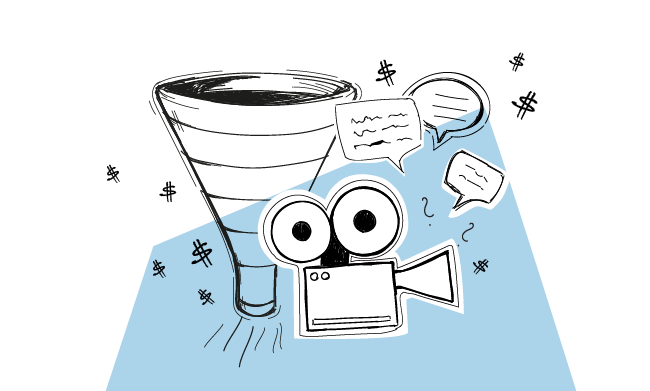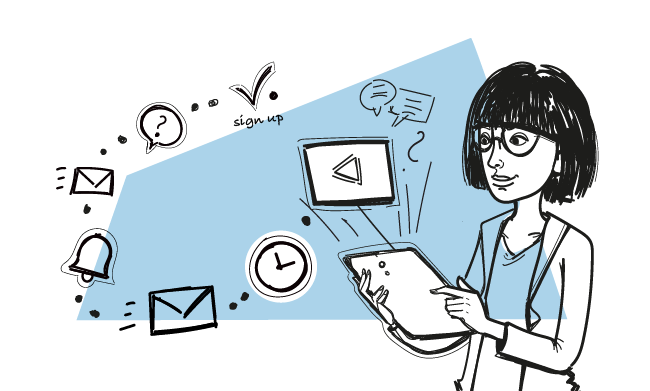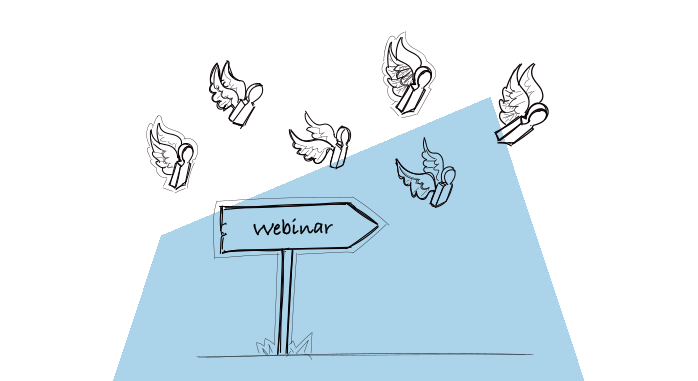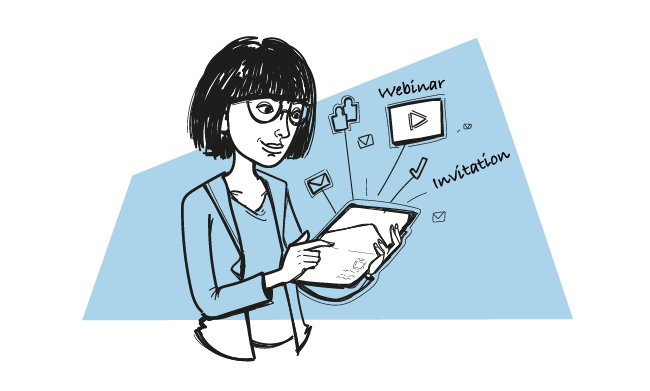When you get started on planning a webinar presentation, one of your tasks is to attract as many people as possible to attend. At some point, you have to start spreading the word about the upcoming event and send out the invitations. That’s our focus in this post — using effective webinar invitation emails to form a virtual crowd at your next online event.
Ready to increase the size of the crowd at your future virtual events? It’s time to learn about the role and importance of webinar invitation emails.
Webinar invitation email checklist
There’s more than one way to write a great webinar invitation email but there are certain ‘musts’ that you need to remember to include. A good webinar email sequence will all contain these elements:
- The practical basics. Here I mean the key things any guest might need to know, like the date, time and other details of the webinar and the webinar topic. Add the name and short bio of the webinar presenter if there is one. A list of guest speakers and hosts. This isn’t always relevant, but when it is be sure to give your invitation email recipients a chance to meet the speakers they will see during the webinar as well as the webinar hosts they will meet.
- What knowledge will be shared. You’ve probably seen the familiar construction of “In this webinar you’ll learn…” already. That’s because it gets to the point in an eye catching way while saving the reader’s time. Encourage recipients to take action. There are different kids of calls to action but they all take advantage of the fear of missing out on what will be a useful, enlightening presentation. There’s nothing wrong with “Register now!” (don’t forget to include the registration link) but try something with a little more sense of urgency like “Grab your VIP ticket” to try to get them to register right away.
- Confirmation emails. Getting people to register can be difficult so don’t waste any time confirming that everything is ready once they decide to sign up. Personalize the confirmation email with the recipient’s name, thank them for their interest, assure them it will be worth their time, confirm the webinar date and time and include the webinar title in the email subject line.
- Use your confirmation email wisely. In addition to thanking attendees and confirming their registration, you can use your confirmation email to do other things like share your social media pages, inform recipients about other virtual events you’re organizing, promote your next webinar if it’s already scheduled. You may be able to add an “add to calendar” link for a reminder.
- Reminder emails. One week until your webinar? One day? One hour? Use reminder emails to notify webinar attendees when the date and time is almost here.
Your webinar email invitation and the webinar confirmation email email you send after someone signs are up are important parts of the overall experience. It’s more than a chance to share key webinar details, it’s like an introduction to your presentation before it even starts.
If you organize webinars frequently, it’s worth experimenting and developing a webinar invitation email template based on elements that have proven to work. Simple invitations to “Join us!” might be perfect for your audience but the best webinar invitation is one that simply gains their interest and makes it easy to sign up.
Best practices for writing a webinar invitation email
Before you get down to writing the invite, define the target group you want to reach out to. Are they your customers? Trial users? Or contacts you found on LinkedIn, Quora, Facebook group etc.?
Why is it such a crucial step?
People who have heard little or nothing about your company and product will need more context to understand why you contacted them and the value of your webinar for them. Your customers or trial users won’t need such an intro.
Knowing your target group will also help you better adjust the tone of your webinar invite and make it either informal and written in an easy-going way or rather stick to more formal language. In any case, avoid making the webinar invitation too long. Try to sum up the main idea in a sentence or two, maybe in a few bullet points. Leave the details for follow-up emails.
Personalized and simple messages without too much HTML are more likely to be delivered straight to the main inbox. So even though your webinar invite will be based on a template, add a personal touch to each message with custom fields, or snippets as we call them in Woodpecker. For example, if you put a snippet like “{{FIRST_NAME}}” into your webinar invite, it will turn into each contact’s name automatically.
But personalization is also crucial to make your webinar invitation stand out from the crowd and get noticed. Let’s see how it looks in practice.
Webinar invitation subject line examples
The problem with subject lines from webinar invitation emails I noticed in my own inbox is that they are all pretty much the same: they are impersonal and have an automatic, generic, impersonal feel. That’s why so many webinar invites get buried under hundreds of other emails and never get any attention.
To give your webinar an opportunity to get noticed in the crowd of other emails, add some personalization to the subject line. It’s definitely worth it since the average open rate of campaigns with a personalized subject line is 10% higher than with a non-personalized one.
When personalizing a webinar invitation subject line you can mention the addressee’s name, their company name or simply refer to a webinar target group, like “sales managers”, “startup founders”, “tech leaders”, etc.
Have a look at these sample webinar invitation subject lines I found when doing research for this article:
{{FIRST_NAME}}, take part in “SaaS Marketing 2020” without leaving home
Boost your business growth this year – here’s your webinar invite
{{FIRST_NAME}}, transform your approach to lead generation
Out of the box solution for {{Company_Name}}
{{FIRST_NAME}}, join a webinar on Prospecting Tips & Tricks
{{FIRST_NAME}}, register to our webinar and catch some tips on effective prospecting
30-minute exclusive webinar: How to improve customer retention with email?
{{FIRST_NAME}}, book your place on our customer support webinar
{{FIRST_NAME}}, reserve your seat for Saas Marketing 2020 Webinar
{{FIRST_NAME}}, you’re invited to Prospecting beyond LinkedIn Webinar
Webinar for sales managers: How to set achievable sales goals for your team?
{{FIRST_NAME}}, save the date: SaaS Business Growth 2020 Webinar
So the content of your webinar invitation is obviously important but it’s only part of the equation. Another important matter is the length — How long should your subject line be?
There’s no one “correct” answer here and success comes from both art and science. Shorter subject lines get attention more easily when a person is browsing through emails. Longer subject lines that include a webinar topic, however, are more informative, yet often get cut short by email clients. I recommend doing A/B tests to learn more about which approach works better in your case.
5 webinar invitation email examples
Now let’s move to the webinar invitation itself. It’s hard to find webinar invitation best practices or the perfect solution to the challenge of getting people to attend your webinar but there are things you can do to make them want to attend.
Free webinar follow-up templates – ebook
If you’re up for more webinar templates for webinar follow-ups that drive conversions, check out our ebook. You’ll find great advice and well-crafted tips for getting your message out and attracting a crowd to your next virtual event!
If you’re preparing an outbound campaign with your webinar details to people who you have never contacted before, give the recipient the context for why you reached out to them in the first place, just like in the below webinar invitation email example:
Hi {{FIRST_NAME}}
I came across your profile on {{snippet_1}} and wanted to reach out to you to see if you’d be interested in our upcoming webinar on automating lead generation.
During the webinar I’ll show you how you can automate the manual part of following up with leads and do it in a scalable, yet still personalized way. You’ll get some valuable insights that will help you create a lead-gen machine!
If you’re interested in registering, click here: [link]
Or like in this sample webinar invitation:
Hi {{FIRST_NAME}}
I noticed the question you asked on {{snippet_1}} group on Facebook considering data enrichment for marketing and sales and thought that maybe you’d be interested in the upcoming webinar I’m hosting.
I’ll be talking about how you can get more accurate lead data without googling and how to use that data to boost your revenue.
The webinar will take place on July 7, at 4 p.m. EDT. Here’s a registration link: [link]
Hope to see you!
Things look different when you create a webinar for trial users or inbound leads. These groups already know your company and your product, so you don’t have to put so much context into the intro. You can get straight to the point.
{{FIRST_NAME}},
I just want to let you know about a webinar that we’re co-hosting with Owl on Wednesday October 4, at 5 p.m. EDT.
We’ll be talking about how data enrichment can boost B2B sales. Save your spot and join us for this great opportunity to increase sales. Here’s the registration link: [link].
Hope to see you there!”
“Hi {{FIRST_NAME}}
You can try something more advanced and prepare a special invite for a chosen segment of your inbound leads or trial users. For example, those who downloaded an ebook on a topic connected to the focus of your webinar or event:
Dear {{FIRST_NAME}},
I hope you found the {{snippet_1}} ebook helpful.
I’d like to invite you to a webinar for Tech leaders that I believe will also be interesting to you since it’s closely connected to what’s in the ebook. During the “Why Agile?” webinar we’ll be talking about the latest developments in the Agile space.
Don’t miss it! Here’s the registration link: [link]
Send webinar invitations at scale
Hope you found some inspiration in the webinar invitation templates and you won’t get stuck at “hello” anymore. Don’t forget to personalize your email and keep it simple, so it will reach the addressee’s inbox directly.
Sending webinar invitations is just the beginning of your webinar sales funnel, though. To increase webinar signups and generate more leads after the webinar you need to plan a webinar follow-up sequence.
FAQ
How can I create an effective webinar invitation email?
To create an effective webinar invitation email, include key details like the webinar description, date and time, and a clear call to action for registration. Make sure the email is tailored to your target audience and highlights the valuable insights attendees will gain. Using a compelling subject line can also boost click-through rates.
What are some good examples of webinar invitation emails?
Good examples of webinar invitation emails typically have a clear and engaging subject line, a concise description of the webinar’s content, and a direct invitation, like “Join us,” to encourage registration. They also include a link to the registration page and emphasize the benefits of attending the webinar.
How can I use email sequences to promote a free webinar?
For promoting a free webinar, start with an announcement email, followed by a series of reminder emails leading up to the event. After the webinar, send post-webinar emails, which could include a link to the webinar replay and a short post-webinar survey to gather feedback.
What should be included in webinar invitation email templates?
Webinar invitation email templates should include a compelling invitation, details about the webinar (topic, date, time, speakers), a clear call to action for registration, and links to the webinar registration page. It’s also effective to include a brief teaser of what attendees will learn or how they will benefit.
Can you provide examples of webinar invitation email sequences?
A webinar invitation email sequence can start with an initial invitation email, followed by a series of reminder emails as the webinar date approaches. These emails should reinforce the value of the webinar and remind registrants of the date and time. After the webinar, send a thank you email with a link to the replay and a survey.
How important are reminder emails in a webinar email sequence?
Reminder emails are crucial in a webinar email sequence as they help keep the event at the top of attendees’ minds and can significantly reduce no-show rates. They should be sent at strategic intervals, such as a week before, a day before, and on the day of the webinar.
What makes a good webinar invitation call to action?
A good webinar invitation call to action should be clear, concise, and compelling. It should encourage immediate action, like “Register Now” or “Save Your Spot.” The call to action should stand out in the email, either through button placement or contrasting colors.
How can I boost the registration rates for my webinar through email invitations?
To boost registration rates, ensure your webinar email invitations are clear, engaging, and highlight the unique value of the webinar. Personalize the emails where possible, and make the registration process simple and straightforward. Including testimonials or previews can also entice more sign-ups.
What are some tips for sending post-webinar emails?
Post-webinar emails should thank attendees for joining, provide a link to the webinar replay, and include a short survey to gather feedback. You can also use this opportunity to provide additional resources related to the webinar topic or announce upcoming webinars.
READ ALSO

How to Create a Webinar Sales Funnel and Boost Webinar ROI?
In search of new ways to boost sales these days, many companies have started hosting webinars. For some, it’s uncharted territory and a new challenge to deal with. Others look for smart ways to scale their existing efforts. No matter if you’re a webinar newbie or you already have some experience in this field, a smooth, efficient, and scalable process should be the foundation of your webinar sales funnel. Let me show you how you can leverage the power of automation to generate and nurture your webinar leads until they try your product.

Webinar Follow-up Templates for Your Webinar Email Sequence
A few posts back I showed you how you can maximize your webinar ROI by creating a webinar sales funnel. The foundation of the funnel are the follow-up emails for each stage: to drive more registrations, boost the show-up rates and post-webinar conversion. In this blog post you’ll find a bunch of email templates for each stage of the webinar sales funnel and a few tips on how to turn more webinar attendees into customers.

How to Generate More Leads After a Webinar?
I'm sure you can agree that webinars are time-consuming and stressful. Not only do you have to carefully plan the whole thing out, but you also need to oversee a lot of things, such as recording & sound quality, take care of the Internet connection, plus you need to make sure there's enough space for everyone to attend the webinar.

